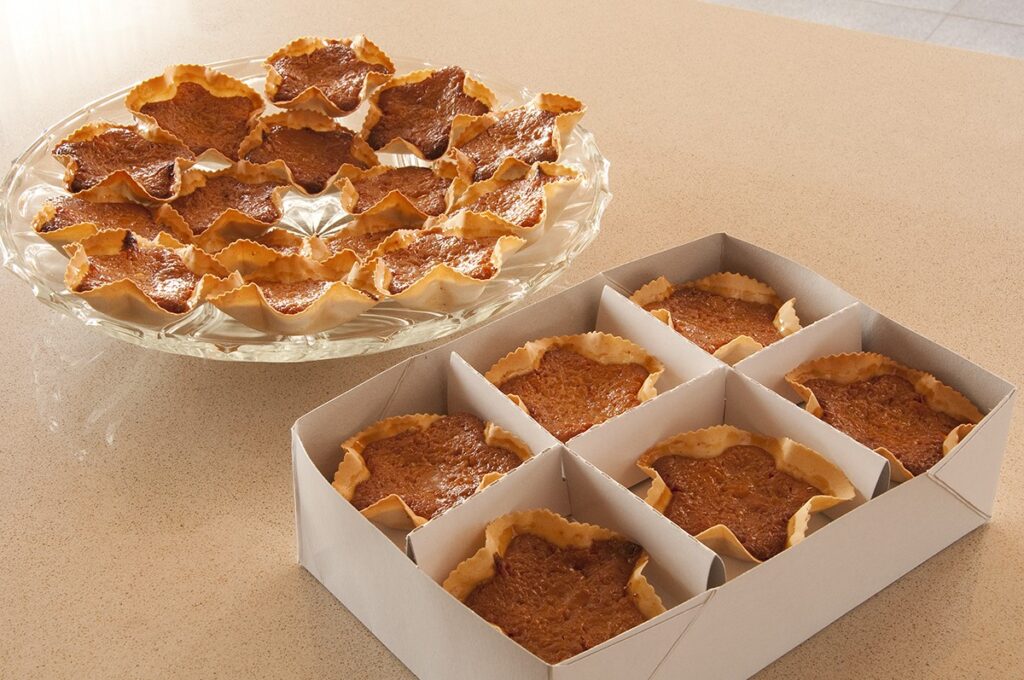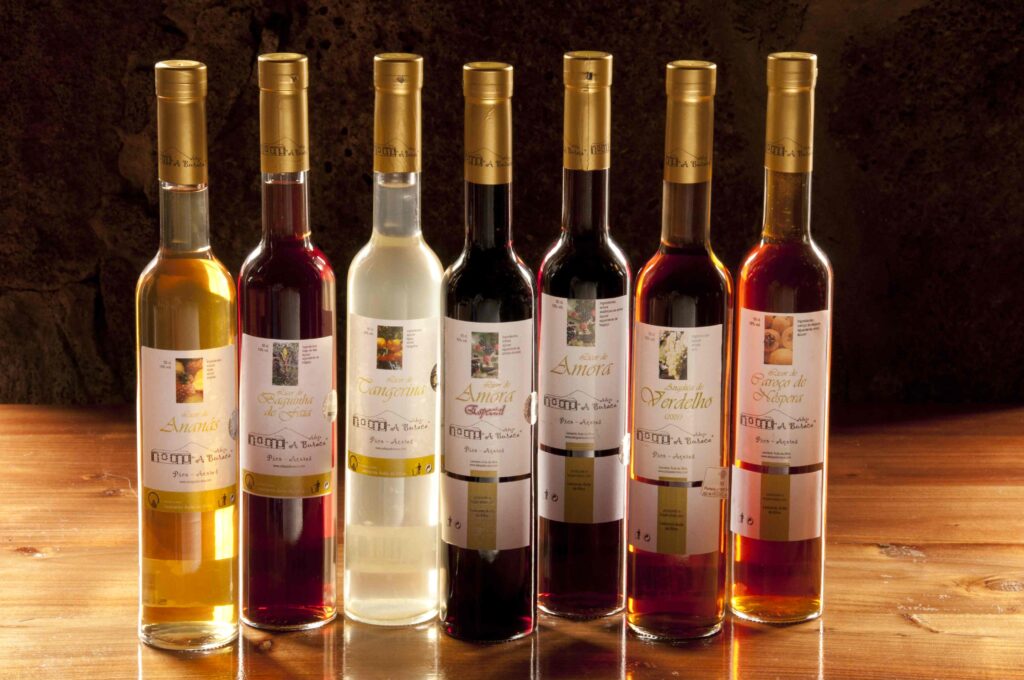Travel Consultants
Is your time too precious to spend long hours searching for the perfect holiday in the Azores? Looking for expert help in organizing your trip? Hire an Azores.com Travel consultant.


Source: Centro de Artesanato e Design dos Açores
Just imagine discovering a culinary paradise where centuries-old Portuguese traditions blend with unique island ingredients to create extraordinary desserts you won’t find anywhere else. The Azores archipelago offers an impressive array of traditional sweets that reflect the islands’ rich cultural heritage, from convent-inspired custard tarts to spice-laden cookies that tell stories of maritime trade routes. Your sweet tooth will be delighted by these authentic delicacies, each carrying the distinct flavors of the subtropical weather, volcanic soil, Atlantic climate, and generations of island craftsmanship that make Azorean desserts truly exceptional.
Portuguese settlers arrived in the uninhabited Azores during the 15th century, bringing their culinary traditions to nine volcanic islands scattered across the Atlantic. Monastic communities, particularly convents in Vila Franca do Campo and Angra do Heroísmo, developed many of the region’s signature sweets using abundant local eggs, milk, and sugar from early trade connections. The islands’ strategic position along maritime trade routes introduced exotic spices, molasses, and techniques that transformed simple Portuguese recipes into distinctly Azorean delicacies that have endured for over 500 years.

Author: Rita Candeias, 2022.
Volcanic soil and temperate oceanic climate create unique growing conditions that directly shape Azorean dessert flavors. São Miguel’s Gorreana tea plantation, Europe’s only commercial tea estate, produces the green tea used in pudim de chá verde, while the island’s mineral-rich soil yields exceptionally sweet passion fruit and oranges. Graciosa’s limestone-filtered pastures produce the creamy cheese imperative for their star-shaped queijadas, and Pico’s volcanic slopes nurture almonds that develop intense flavors from the nutrient-dense terrain.
Each island’s microclimate influences ingredient availability and flavor profiles in remarkable ways. Terceira’s higher elevation and cooler temperatures preserve spices longer, explaining the complex spice blends in Dona Amélia cakes, while São Jorge’s windy coastal conditions concentrate flavors in their fennel and anise, making their espécies cookies particularly aromatic. The islands’ isolation also meant preserving techniques became imperative – honey from local bees, molasses from trade ships, and dried fruits created the dense, long-lasting cakes like bolo baleeiro that could withstand Pico’s harsh whaling seasons. Your taste experience varies dramatically between islands, with Santa Maria’s drier climate producing crisper biscoitos de orelha, while Flores’ abundant rainfall creates lusher, more delicate orange pastries.
These iconic custard tarts from Vila Franca do Campo represent São Miguel’s most beloved sweet treat. Created by nuns in the 17th century, these creamy delicacies combine eggs, sugar, milk, and butter in small fluted molds. You’ll find them served cool or at room temperature, making perfect souvenirs that capture the essence of monastic baking traditions. Local bakeries still follow the original recipes, ensuring each bite delivers the same rich, custard-like texture that has delighted visitors for over 400 years.

Source: Centro de Artesanato e Design dos Açores

Source: Centro de Artesanato e Design dos Açores
Named after Queen Dona Amélia’s 1901 visit to Terceira, these spiced cakes showcase the island’s historical connection to maritime spice trade. The rich blend of molasses, honey, cinnamon, dried fruits, and exotic spices creates a complex flavor profile that reflects Terceira’s strategic position in Atlantic commerce. You’ll encounter these treats served in bite-sized portions, dusted with powdered sugar, and paired perfectly with local coffee or tea.
The cake’s distinctive spice blend tells the story of Terceira’s role as a crucial stopover for ships carrying precious cargo from distant lands. Bakers traditionally prepare larger batches during the Festas Sanjoaninas and Festas do Espírito Santo, when the aromatic spices fill entire neighborhoods. The molasses provides deep sweetness while dried fruits add texture, creating a dessert that improves with age as flavors meld together over several days.

Source: Centro de Artesanato e Design dos Açores
This soft, sweet flatbread originated in Furnas, São Miguel, where families have passed down recipes through generations. Made with flour, sugar, butter, and sweet yeast dough, bolo lêvedo serves as both dessert and comfort food. You’ll discover its versatility during breakfast or tea time, when locals top it with butter, jam, or cheese. The gentle cooking process on flat grills creates its characteristic texture and golden appearance.
Furnas’ volcanic environment influenced this bread’s development, as families needed portable, satisfying foods for long days tending crops or working near the geothermal areas. The sweet yeast dough requires careful temperature control, something local bakers mastered using traditional wood-fired ovens. Modern versions maintain the same tender crumb and subtle sweetness, though you’ll find the best examples still come from small family bakeries that cook them on well-seasoned griddles passed down through generations.

Source: Centro de Artesanato e Design dos Açores
Graciosa’s star-shaped cheese pastries celebrate the island’s exceptional dairy traditions. These unique treats combine eggs, local cheese, sugar, and flour to create pastries that showcase Graciosa’s high-quality milk products. You’ll taste the difference that volcanic soil and Atlantic climate make in the cheese’s flavor, which provides a subtle savory note balancing the sweetness. Best served slightly warm alongside Azorean coffee, they represent the island’s agricultural heritage in every bite.
The star shape distinguishes Graciosa’s queijadas from similar pastries found elsewhere in the Azores, reflecting local bakers’ pride in their distinctive creation. Graciosa’s smaller size and focused dairy industry means cheese quality remains consistently high, with many families still maintaining traditional cheesemaking methods. The island’s volcanic soil produces exceptionally rich milk, which translates into cheese with complex mineral notes that enhance these pastries’ flavor profile. Local festivals often feature queijada-making demonstrations, where you can observe the precise technique required to achieve the perfect star pattern.
These golden pillows of fried dough represent Carnival’s ultimate indulgence across all nine islands. You’ll find malassadas at their peak during February’s pre-Lenten festivities, when bakeries work overtime to satisfy demand for these yeast-raised treats. The dough gets fried until perfectly puffed and golden, then generously dusted with cinnamon sugar while still warm. Terceira’s version often incorporates citrus zest or a splash of local aguardente for added complexity.
Source: Centro de Artesanato e Design dos Açores
Azorean rice pudding elevates this Portuguese classic with pronounced citrus notes that reflect the islands’ abundant lemon groves. You’ll encounter this creamy dessert at Christmas tables, Easter celebrations, and family gatherings throughout the year. The pudding combines short-grain rice with whole milk, sugar, eggs, and generous amounts of lemon zest for a bright, aromatic finish that distinguishes it from mainland versions.
The artistry of arroz doce extends beyond taste to visual presentation. Skilled Azorean cooks create intricate cinnamon patterns on the pudding’s surface using small sieves or stencils, forming delicate lace-like designs, floral motifs, or geometric patterns. These decorative touches transform a simple dessert into an edible masterpiece worthy of special occasions. The pudding’s consistency should be creamy yet firm enough to hold these cinnamon decorations, achieved through careful temperature control and the precise ratio of rice to liquid during cooking.

Source: Centro de Artesanato e Design dos Açores
Santa Maria’s signature Christmas biscuits earn their name from their distinctive ear-like loops and twists. You’ll only find these delicate cookies during the holiday season, when families hand-shape the buttery dough into intricate designs before baking. The addition of fresh lemon zest provides a subtle citrus note that balances the rich butter content, creating cookies that are both crisp and aromatic.
The preparation of biscoitos de orelha requires considerable skill and patience, as each cookie must be individually twisted by hand into its characteristic shape. Master bakers on Santa Maria guard their techniques closely, passing down methods for achieving the perfect balance between delicate texture and structural integrity. The cookies serve as both treats and gifts during Christmas and New Year celebrations, often packaged in decorative boxes and exchanged between families as tokens of goodwill. Their intricate shapes make them conversation pieces at holiday gatherings, where guests admire the craftsmanship before savoring the buttery, lemon-scented flavor.
This innovative dessert showcases São Miguel’s unique position as home to Europe’s only tea plantations at Gorreana. You’ll taste the delicate earthiness of locally grown green tea transformed into an elegant steamed pudding, topped with golden caramel. The dessert represents a modern interpretation of traditional Portuguese pudim, incorporating the island’s 150-year-old tea-growing heritage into contemporary Azorean cuisine.
The creation of green tea pudding requires careful extraction of tea flavors without introducing bitterness that could overpower the dessert’s subtle sweetness. Gorreana’s tea leaves are steeped at precise temperatures to create a concentrated infusion that’s then incorporated into a custard base of eggs, milk, and sugar. The pudding is traditionally steamed rather than baked, resulting in an incredibly smooth texture that allows the tea’s grassy, vegetal notes to shine through. Tea house restaurants near the Gorreana plantation serve this dessert in individual ramekins, often accompanied by additional green tea for a complete sensory experience that celebrates São Miguel’s agricultural heritage.
This dense, molasses-rich cake from Pico Island pays homage to the archipelago’s whaling heritage that dominated the 19th century. The dark sweetness comes from imported molasses that arrived on whaling ships, while local honey and warming spices create layers of complex flavor. You’ll find this cake wrapped and aged like fine wine, developing deeper notes over time that pair beautifully with Pico’s volcanic wines.
São Miguel and Pico’s almond groves produce the star ingredient for this elegant Portuguese-influenced tart. The buttery pastry cradles a rich almond filling made from locally grown nuts, creating a dessert that showcases the islands’ agricultural heritage.
Local bakers caramelize whole almonds on top, creating a golden crown that provides textural contrast to the smooth filling beneath. The tart’s preparation varies slightly between islands – São Miguel versions tend toward a creamier custard-like center, while Pico’s interpretations feature a denser, more intensely almond-flavored filling. You’ll often encounter these tarts at religious festivals and family celebrations, where they’re served alongside strong Azorean coffee that complements the nutty sweetness perfectly.
Perhaps the most surprising entry in Azorean dessert tradition, these sweetened blood sausages transform what you might expect into an unexpectedly delightful treat. Made primarily on São Miguel and Terceira, they combine pork blood with sugar and aromatic spices during late summer harvest celebrations.
The preparation follows centuries-old techniques where families gather during pig slaughter season, typically coinciding with wine harvest festivals in early fall. Unlike their savory counterparts, morcelas doces develop a subtle sweetness that balances the rich, earthy flavors of the blood. You’ll find them served cold on celebratory platters alongside local cheeses, crusty bread, and young wine. The contrast might seem unusual to outsiders, but locals consider them an crucial part of traditional feast tables, representing the resourceful spirit that defines Azorean cuisine.
Christmas transforms Azorean kitchens into aromatic workshops where families prepare traditional sweets weeks in advance. Bolo de Mel (Christmas Honey Cake) takes center stage on Terceira and São Miguel, wrapped tightly in cloth and aged for enhanced flavor complexity. Santa Maria’s distinctive Biscoitos de Orelha showcase intricate hand-twisted shapes resembling ears, gifted between neighbors as symbols of holiday goodwill. Rice pudding (Arroz Doce) appears on every Christmas table, decorated with elaborate cinnamon patterns that tell stories through their lace-like designs.
Malassadas reign supreme during Carnival season, filling bakeries across all nine islands with their golden, sugar-dusted presence. These fried dough treats represent the final indulgence before Lenten fasting begins, with families gathering to prepare massive batches together.
Each island adds its own carnival twist to malassadas – Terceira infuses theirs with local citrus zest and occasionally pairs them with aguardente for adult celebrations. São Miguel versions often incorporate passion fruit filling, while Graciosa maintains the traditional plain recipe but serves them alongside their famous cheese pastries. Carnival celebrations extend beyond malassadas to include special versions of existing treats: extra-sweet queijadas, honey-glazed bolo lêvedo, and spiced cookies shaped into carnival masks. Street vendors set up temporary stalls during the three-day festivities, creating a sweet symphony that accompanies the colorful parades and traditional folk dancing.
Baptisms, weddings, and saint day celebrations call for specific sweet traditions that vary by island and family heritage. Queijadas da Graciosa star-shaped pastries mark special occasions on Graciosa, while São Miguel families serve oversized orange pastries dusted with powdered sugar during milestone birthdays.
Wedding celebrations showcase the most elaborate dessert spreads, featuring multi-tiered displays of almond tarts, passion fruit puddings, and specially commissioned Dona Amélia cakes. First communion ceremonies traditionally include white-decorated rice pudding symbolizing purity, while confirmation celebrations call for the more complex spiced cookies from São Jorge. Family recipe books pass down specific measurements and techniques through generations, with grandmothers teaching granddaughters the precise hand movements for shaping biscoitos de orelha or the exact timing for achieving perfect queijada consistency. These celebrations often extend over multiple days, with different sweets appearing at various stages – lighter pastries during afternoon visits and richer, more substantial desserts for evening feasts.
Your Azorean dessert experience reaches new heights when paired with the archipelago’s exceptional coffee culture. Local cafés serve robust espresso that perfectly complements the sweetness of queijadas da Vila and Dona Amélia cakes. The coffee’s bold flavor cuts through rich custard textures while enhancing the spiced notes in traditional treats. Graciosa’s star-shaped cheesecakes become even more delightful when enjoyed warm alongside a freshly brewed bica, the local term for espresso that locals sip throughout the day.

Source: Centro de Artesanato e Design dos Açores
Pico’s renowned volcanic wines create extraordinary pairings with Azorean sweets, particularly the island’s own Bolo Baleeiro. The wine’s mineral undertones from volcanic soil enhance the molasses and honey flavors in this whaler’s cake. Aguardente, the local sugarcane spirit, transforms simple malassadas into festive treats during Carnival celebrations, while Terceira’s liqueur de maracujá adds tropical notes to any dessert course.
The archipelago’s unique terroir produces wines with distinctive characteristics that complement specific desserts beautifully. Verdelho wines from Pico, with their crisp acidity and citrus notes, pair exceptionally well with orange pastries from São Miguel, creating a harmonious balance between the wine’s brightness and the pastry’s sweet citrus flavors. For richer desserts like arroz doce or green tea pudding, opt for Pico’s late-harvest wines, whose concentrated sweetness and complex flavors enhance rather than compete with these creamy textures. Local distilleries also produce fruit brandies from passion fruit and other island-grown fruits, which serve as perfect digestifs after enjoying traditional Christmas specialties like bolo de mel.
So when you visit the Azores, your culinary journey should include sampling these remarkable traditional desserts that reflect centuries of Portuguese heritage blended with unique island influences. From the iconic Queijadas da Vila of São Miguel to the distinctive spiced cookies of São Jorge, each sweet tells a story of local ingredients, religious traditions, and cultural celebrations. You’ll discover that these desserts aren’t merely treats but edible expressions of Azorean identity, crafted with local dairy, exotic spices, citrus fruits, and even green tea from Europe’s only tea plantation, making your visit truly unforgettable.
A: The Azores offer several iconic desserts that showcase the islands’ rich culinary heritage. The most famous include Queijadas da Vila (custard tarts from Vila Franca do Campo), which originated in the 17th century and are made with eggs, sugar, milk, and butter. Bolo Lêvedo, a sweet flatbread from Furnas, São Miguel, is perfect for breakfast or tea time. Queijadas da Graciosa are star-shaped cheesecakes that highlight Graciosa’s dairy traditions. Bolos Dona Amélia from Terceira are spiced cakes named after Queen Dona Amélia’s 1901 visit, featuring molasses, honey, and cinnamon. These desserts represent the unique blend of Portuguese influence and local Azorean ingredients.
A: Many traditional Azorean sweets are tied to religious celebrations and seasonal festivities. Malassadas (fried dough) are especially popular during Carnival season as a pre-Lenten indulgence, dusted with cinnamon sugar. Arroz Doce (rice pudding) is commonly served during Christmas and Easter, decorated with intricate cinnamon patterns. Bolo de Mel (Christmas honey cake) is prepared weeks before Christmas for aging and makes an excellent holiday gift. Biscoitos de Orelha from Santa Maria are Christmas-specific biscuits shaped into unique ear-like designs. During Festas do Espírito Santo, you’ll find Bolos Dona Amélia and Espécies (spiced cookies from São Jorge) served at communal celebrations.
A: Yes, several desserts showcase ingredients unique to the Azores. Pudim de Chá Verde dos Açores uses green tea from the Gorreana plantation on São Miguel, Europe’s only tea estate, creating a delicate steamed pudding with caramel. Pudim de Maracujá features locally grown passion fruit, reflecting São Miguel’s tropical fruit cultivation. Pastéis de Laranja highlight the prominence of Azorean oranges, particularly significant during the 19th-century orange trade. Morcelas Doces are an unusual sweet blood sausage from São Miguel, served cold during harvest celebrations. Tarte de Amêndoa incorporates almonds from São Miguel and Pico, while Bolo Baleeiro from Pico honors the island’s whaling heritage with dense, molasses-rich cake.
A: Each Azorean island has developed its own dessert specialties. São Miguel is famous for Queijadas da Vila, Bolo Lêvedo, and tea-based desserts due to its tea plantations. Graciosa is renowned for its star-shaped Queijadas da Graciosa, emphasizing the island’s exceptional dairy products. Terceira is the birthplace of Bolos Dona Amélia, while São Jorge is known for Espécies, heavily spiced ring-shaped cookies reflecting the island’s spice trade heritage. Pico offers Bolo Baleeiro, honoring its whaling history, and Santa Maria produces unique Christmas Biscoitos de Orelha. While basic recipes may be similar across islands, each location adds its own twist using local ingredients and preparation methods, creating distinct regional variations.
A: Traditional Azorean desserts often involve time-honored preparation methods passed down through generations. Queijadas are baked in small fluted molds and served cool or at room temperature. Bolo Lêvedo is cooked on flat grills and served warm with butter or jam. Malassadas are hand-fried until golden and immediately dusted with sugar. Rice pudding is decorate